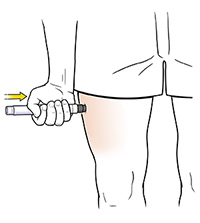Discharge Instructions: Using an Autoinjector
Your healthcare provider has prescribed a medicine that you will need to inject through your skin. This is done with an autoinjector. It is a small device with a hidden needle. The needle is activated by a spring. This makes giving yourself a shot easy. It also makes it easy for someone else to give you a shot if you can’t do it yourself. There is no need to look for the best injection site or to give the shot in the buttocks or arm. Use any site on the outer side of your thigh. The shot can be given through clothing if necessary. Be sure your family members and friends know where to give the shot.
 |
| Activate the autoinjector by removing the cap |
 |
| Jab the autoinjector into the side of the thigh |
Home care
Inject your medicine as often as advised by your healthcare provider. Follow any instructions from your healthcare provider about the medicine. To give yourself a shot:
-
Remove the safety cap from the autoinjector. This activates it.
-
Point the tip of the autoinjector at the outer side of your thigh. Jab it against your thigh. This releases a spring-activated plunger that pushes the needle into the thigh muscle and gives you a dose of medicine. Hold the pen in place for 10 seconds. Then pull the pen straight out, away from the thigh, to remove the needle. Massage the area where you injected the medicine for about 10 seconds.
-
Dispose of the autoinjector as instructed.
-
If your autoinjector is for emergency medicine (such as epinephrine for an allergic reaction), call 911 and get to the nearest emergency room. Don't drive yourself. Be aware that you may need a second injection if you are still having the reaction or symptoms.
Follow-up care
Follow up with your healthcare provider, or as advised.
Call 911
Call 911 right away if you have any of the following signs of severe allergic reaction:
-
Racing pulse
-
Wheezing, coughing, or trouble breathing
-
Stomach cramping, diarrhea, or vomiting
-
Hoarse voice
-
Swollen lips, tongue, or throat
-
Trouble swallowing or feeling like your throat is closing
-
Itchy, blotchy skin or hives
-
Pale, cool, damp skin
-
Confusion
-
Drowsiness, fainting, or loss of consciousness
Online Medical Reviewer:
Eric Perez MD
Online Medical Reviewer:
Jessica Gotwals RN BSN MPH
Online Medical Reviewer:
Paula Goode RN BSN MSN
Date Last Reviewed:
2/1/2022
© 2000-2024 The StayWell Company, LLC. All rights reserved. This information is not intended as a substitute for professional medical care. Always follow your healthcare professional's instructions.